Lamenting the loss of local Perth TV content and investigating modern means for re-cultivating it… regaining some semblance of local control.
If you want to know where the local bands are playing, the newest show in town and where’s the latest club or nightspot in Perth, then television is no longer the best place to look, unless people have discovered it on the Community TV channel, Community Radio Station, or newspaper? We were better informed when there was lots of local live shows on 7, 2 and 9. Not only that but Seven and Michael Edgley were cross promoting everything from the Great Moscow Circus, the Bolshoi Ballet to Disney On Parade. At His Majesty’s Theatre, in the big tent or at the Perth Entertainment Centre. Entertainers from far and wide were appearing on ‘In Perth Tonight’ and at popular nightclubs like La Tenda. ‘Club 7 Teen’ and Johnny Young had guest performers and promoted the local bands, which appeared at the Embassy, Canterbury Court or any number of popular venues. Seven and Nine conducted a number of talent quests from ‘Perth’s New Faces’, ‘The Entertainers’ to ‘Stars of the Future’ and ‘Young Entertainers’. Radio also did an excellent job promoting all manner of local attractions, often supported by competitions and other forms of public involvement.
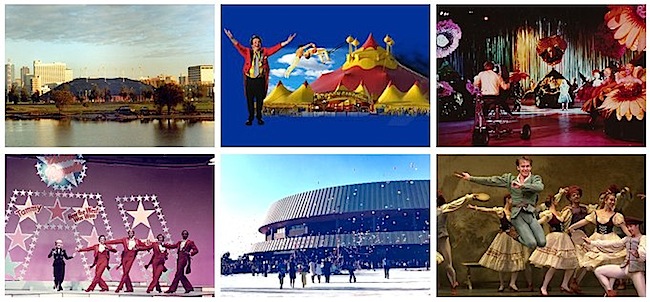
Rather than reporting on the exciting aspects of nightlife and entertainment at Northbridge, Fremantle and all around town, now we’re more often likely to get TV news reports of antisocial behaviour. At least the local variety shows of yesteryear concentrated on what’s happening in Perth with an emphasis on the fun and good news stories. Visiting celebrities, interviews with colourful characters, local satire, comedy sketches with song and dance sequences. There isn’t the scope or opportunity to dwell on the local scene as there was, unless it can fit in with the nightly news spot.
Television decisions that were once made in Perth are now made in Sydney or Melbourne.
Reflecting over the past fifty years and more, one can easily experience a degree of melancholy for what we’ve had and what we’ve lost. When television station control was diversified there was scope for each state to experiment, innovate and target the specific needs and tastes of their communities. We were more parochial back then with the road east still full of potholes and covered in bull dust. Perth was more like a big country town than a capitol city of great consequence. Wanneroo Road was soon surrounded by bush once a vehicle had gone past Dog Swamp. Albany Highway was dotted with small settlements separated by farmland. Cannington, Kenwick, Maddington, Gosnells, Kelmscott and Armadale were distinct identities, not merged as part of the greater suburbia. One did not have to venture far out before encountering a sign preclaiming the end of the metroplitan area.
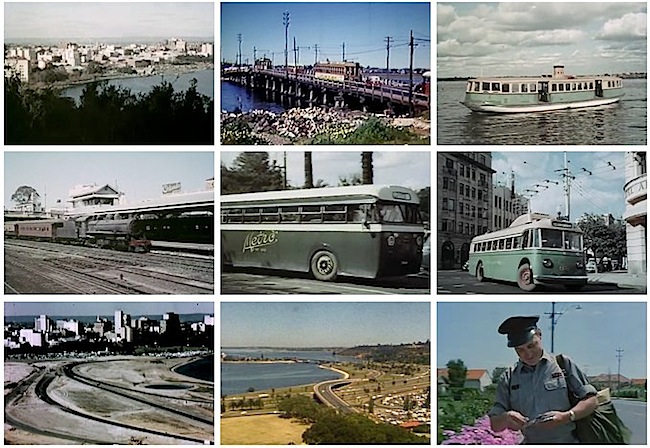
Phone numbers started with a letter, such as M19761, to later be replaced by a number as 619761. Then they added a 3 to the front and later added a 9.

Kalamunda, Armadale, Wanneroo and other areas had county number plates, with Kalamunda being represented by a KM prefix, Armadale was AK and Wanneroo WN.
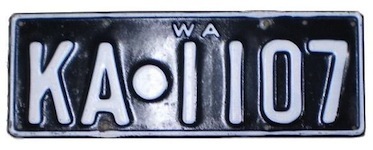
Perth was more isolated then, and by necessity more independent. It wasn’t practical for our milk to come from the eastern states and our perishables were grown locally. Our population was small enough to insulate us from the higher crime rates of the bigger cities, until Eric Edgar Cooke went on his rampage.
There were still quite a few cars with crank handles, vehicles we now consider vintage. Longstroke engines, wooden spoked wheels and canvas roofs were not uncommon. On top of that, the occasional baker and milkman still had a horse drawn conveyance, and the Dunny Cart man was gradually being replaced by the sewerage system, or at least septic tanks..
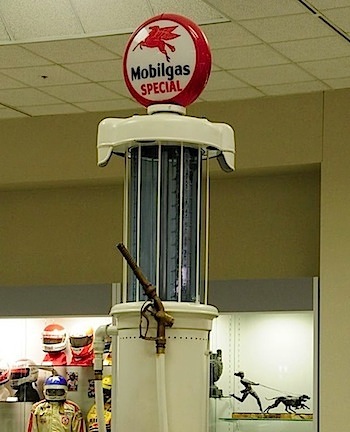
Electric petrol bowsers were replacing the hand pump and the Narrows Bridge was opened in 1959, the same year that television started in Perth.
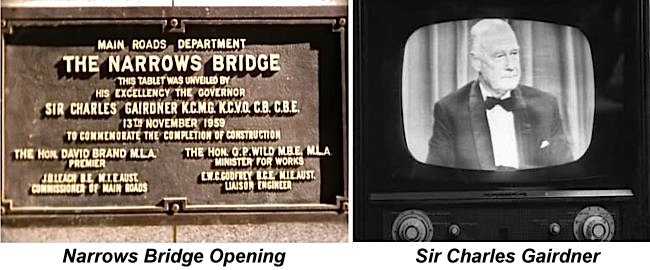
Radio no longer reigned supreme. Our world would never be the same again.
Fast forward to the 1980s, when ‘programmes’ became ‘programs’.
Rather than each television station becoming grander with their programming scope, the opposite happened as ownership fell into fewer and fewer hands. Some resented the way this was done, as a heavy hand was often observed sacrificing the less fortunate for increased profitability and the concentration of control, wealth and the means of production in a centralised location over east.
Both commercial stations and the ABC were affected by this increasing trend.
Staff in WA often referred to the ABC as the Sydney Broadcasting Corporation for the way they greedily wanted everything and took it.
No matter how flawed the decision, Sydney called the shots, there was very little autonomy left. Like the time Perth questioned the highly outrageous nature of a pedophile related national radio program which seemed to glorify the practice and was broadcast by order of Sydney, which then caused federal parliament to erupt and budget consequences the ABC suffered for decades thereafter. Unfortunately every other branch is affected when Sydney shoots itself in the foot.
One could be forgiven for thinking that head office perceived itself as having a monopoly on brains and that all other states should follow slavishly.
The head office culture still seems to be strong today as our article Reports on ABC Programs and Staff touches on.
Every so often the notion of WA secession pops up with grievances about Canberra’s interference. People are always questioning the quality of decisions made and how well represented we are by the parliamentarians. Old media is also considered part of the problem with its fascination with short sound bites rather than detailed analysis. This concern has been exacerbated by the ‘News of The World’ affair in Britain, where the media ethics are now under close examination. New media provides interactive avenues to vent one’s spleen and share views and dissent through social networking. People can also self publish on Blogs and upload their case as a video on YouTube. Email is also a powerful tool for circulating ideas. Anything that is a true revelation soon goes viral. Though most of the viral content consists of jokes, cartoons and funny pictures, often lampooning the politicians in Canberra.
The Internet inadvertently provides the tools to assist revolutions, such as that taking place in the middle east. Its one of the great forces changing the world and it has little respect for borders or dictators. It is gradually white anting a number of repressive regimes. The Internet revolution is subtle and can confound those who do not understand it. This is presently having an impact on the retail sector with consumers preferring to buy on-line, where they can find great bargains.
The Internet also has an impact on the broadcasting industry, where at first little notice was taken until the ABC began innovating with a variety of online services which compliment their traditional outlets. The ABC is not influenced by flagging newspaper circulations or a tendency for advertisers to shift their focus online. They can try new things without fighting a rear action, unless a powerful lobby group persuades the government that the ABC should be sold like Telstra, the Commonwealth Bank, Aussat, and Qantas or at worst disbanded. The Murdoch empire has often argued against the BBC and ABC as seen in their recent attempt to wedge the Australia Network away from the ABC.
The Australia Network is funded partially by Australia’s Department of Foreign Affairs and Trade, as well as some advertising. The channel is targeted at local audiences in 44 countries across parts of Asia, the Pacific and India.
All Australian television networks now have an online component, some more than others.
At the end of this article we’ll examine the ramifications the Internet is having on our present broadcasting model, and how the ordinary people can now participate more in the generation of content. They also have more control over what they see. Local content may not reappear as it was, but be reincarnated in a different form, more suited to the ever changing methods of program distribution.
Some Interesting Media Trends
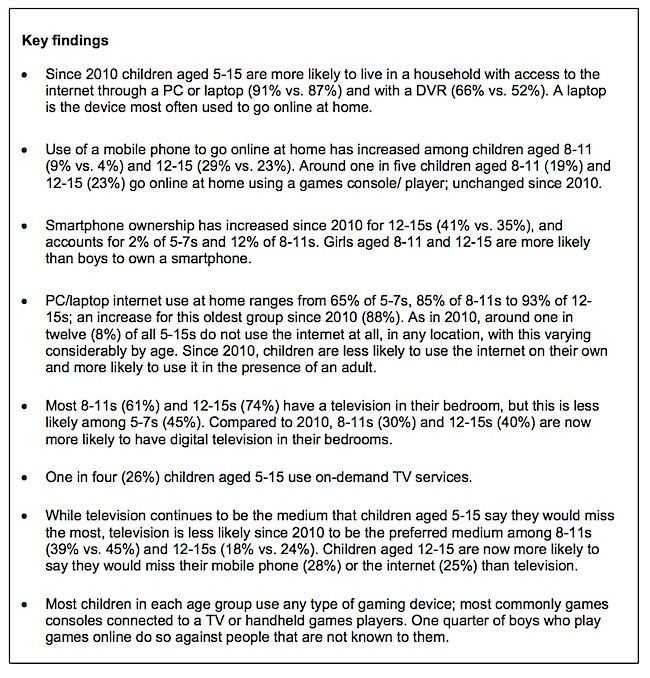
October 2011 research conducted by Ofcom – The independent regulator and competition authority for the UK communications industries
The Perth radio listening public is unlikely to tolerate their breakfast announcers sitting in Sydney and presenting a largely eastern states orientated breakfast session, unless they were conditioned to it, as has happened with our local television audience.
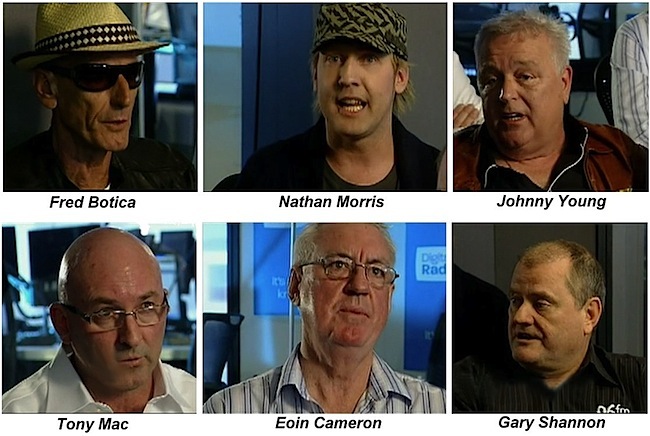
Gone are the popular Earlybirds with Trina Brown, Sandy Baker and all the other morning TV presenters who followed. Gone also are the local children’s programs, along with Fat Cat and his friends, other than saying goodnight at 7:30 pm. Or Flapper the Elephant for those who tuned to Channel 9. The same goes for the local woman sessions, the local evening and teenage variety shows that were highly popular in past decades… and a plethora of other local content on all stations.

Local multi genre evening radio programs were also very popular on Perth ABC radio. More popular in fact than all the other states. Sydney and Melbourne ABC ratings paled in comparison to the keen bunch of presenters who broadcast from the Adelaide Terrace studios, each night from 7pm till midnight on 6WF. Each night was different and each night was special, as they catered for a specific audience without alienating the rest. Familiar voices who were intimate with not only their audience but also the content they presented.
How this came about is interesting as the very early ABC announcers were drawn from people with cultured British accents or a theatrical background. The selection criteria was very strict as recruits needs not only a trained voice, with good reading and breathing skills, but a good general knowledge of languages and current events. They needed to convey an authority as they announced programs and music whilst also able to tackle events such as the Anzac Day parade. There was even a requirement that announcers dress formally, even though their listening audience could not see them. This would eventually change as announcers were drawn increasingly from commercial Radio stations in later years, and a rebellion took place in music. Starting with Bing Crosby and later Frank Sinatra, as popular music started to overtake the classics on the airwaves. Further shattered by the arrival of Rock n Roll, though the ABC did things in moderation, always an alternate to the high sell commercials, who even adopted pseudo American accents at one point, emulating what rated best in the US.
ABC listeners in particular liked the friendly on-air manner, breezy presentation, robust humour and endless variety of jokes from John Juan (1901-1979) which endeared him to thousands of 6WF listeners for thirty-five years. His recognisable signature tunes were, There’ll be a Silver Lining, We’ll Meet Again and Up with the Curtain. His most popular programs were ‘The Breakfast Session’, ‘The Hospital Hour’ and ‘I’ll Pay That One’.
On John Juan’s retirement from the breakfast session in 1974, 6WF’s most popular spot was taken by David Hawkes, who increased the tempo with non stop music with the occasional news, clever quips and endless funny grabs from all manner of amusing moments to remark on what was happening at that time. David exhibited a manual dexterity that few could hope to match in effortlessly manipulating every conceivable device in the studio to orchestrate a bewildering source of music, humour and topical information, to entertain and amuse even those recovering from a hard night and a hangover. David had a particular dislike for lazy lyrics where singers substituted words for repetitive sounds, rather than some meaningful language, which seemed to be a popular fad at the time, and a trend that regularly gets resurrected.
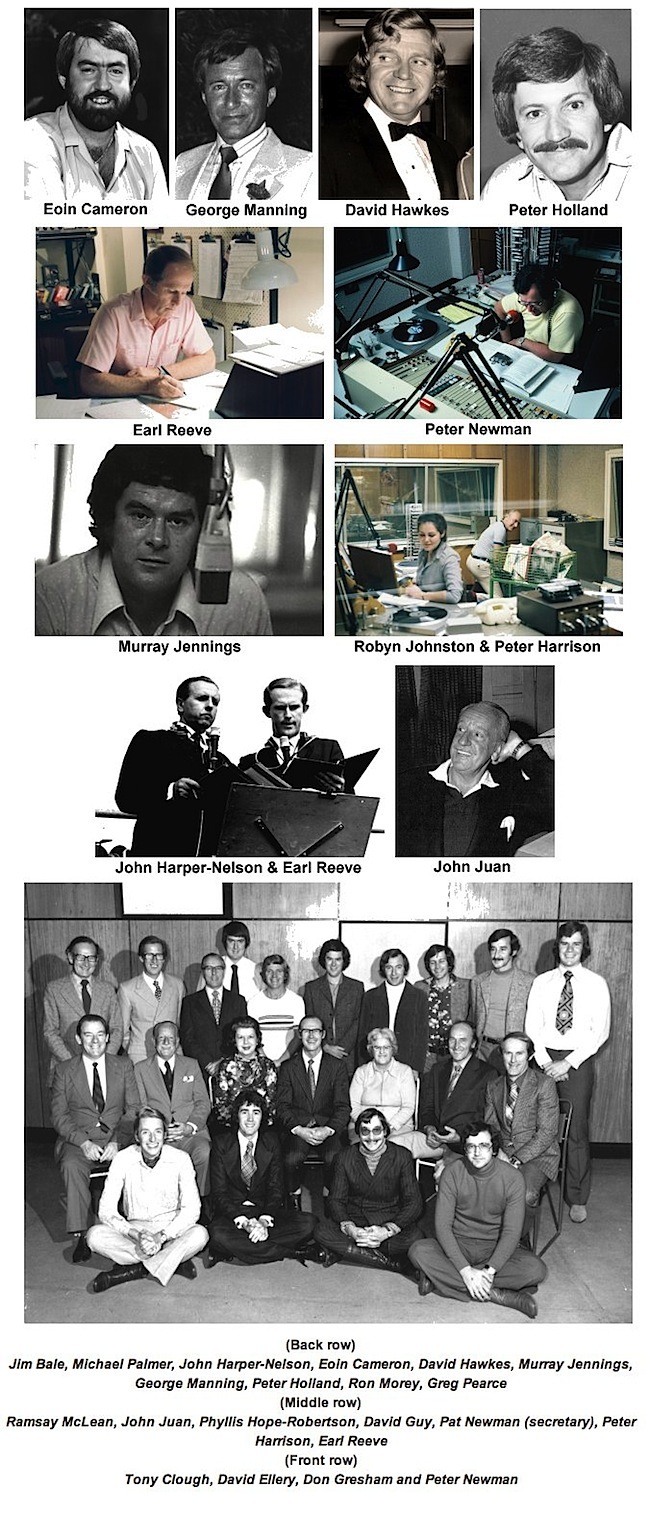
George Manning then took over from David to keep the session in the top ratings. The problem was that everytime an ABC announcer grabbed the top spot, the commercials would grab them. This happened with David, George, and Eoin Cameron, though they all returned to the fold after a period in the commercial wilderness.
The image of the ABC being full of stuffed shirts was not always an accurate one. Former state manager, the late Arthur Povah fondly referred to the family environment at 6WF in the 1930s, when staff numbers were small. There was always a degree of hi jinks taking place away from the microphone, and sometimes in front of it with pranks such as setting fire to news scripts midway through a bulletin. One radio newsreader managed to maintain his on-air decorum whilst being stripped naked by mischievous colleagues, as veteran announcers recall. Staff who worked for ABC radio in Perth have fond memories of the camaraderie that existed among the announcers, even at times when management seemed to be an obstacle.
Pride in their work and a high degree of professionalism was always exhibited on air, though sometimes the damnedest things would happen which would surely test the sanity of staff and be of wonderment to the audience.
On once occasion, Sydney decided to supply the two minutes of silence for Remembrance Day on a tape recording. The tape started with the Last Post, as a final farewell to symbolise that the duty of the dead is over and they can rest in peace, to be followed by two minutes of silence at “the eleventh hour of the eleventh day of the eleventh month” so that “in perfect stillness the thoughts of everyone may be concentrated on reverent remembrance of the Glorious Dead”. It is tradition to break the silence by playing Reveille, which symbolises an awakening in a better world for the dead, and also rouses the living back to duty, now their respects have been paid to the memory of their comrades. Unfortunately, the tape contained no Reveille, which meant the silence well exceeded the specified two minutes as studio staff went into panic mode. There was a furry of people rushing around on the public holiday trying to locate a recording of the piece. On this particular day the silence extended well beyond ten minutes before Reveille was played from a gramophone record, located after a long search, followed by a breathless announcer returning all stations to their normal programs.
The two minute silence was always a test of the system as the transmitters were programmed to play an apology and standby music should there be a prolonged break. Much like the time some bright spark in Sydney decided to produce a program of new music where one had to imagine the orchestra. The tape contained a variety of announcements giving credit to the creator of this masterpiece, which consisted of multiple segments of dead air. A program that lasted forty five minutes in total, punctuated equally by descriptions of what we should be imagining, then silence, followed each time by transmitter apologies with the same bit of standby music, which soon became painfully repetitious. That was the serious music world of 6WN, which occasionally inflicted some seriously odd things on the listener.
Meanwhile sanity was prevailing on 6WF, the popular music station. Except during those times when the audience was subjected to prolonged sessions of federal parliament.
During the evenings, Earl Reeve had a fondness for Country Music and conveyed that statewide to a captive audience. Earl would smile whilst pointing out that this was a fact, as many of his requests came from the incarcerated in Fremantle Prison.
Peter Harrison played jazz and spoke with an authority that only a former musician devoted to this esoteric genre could impart. Every recording was transported in for the evening from Peter’s home record library, with each cutting as pristine as the day they were pressed. A passion also shared by fellow announcer Ron Morey.
From the late 1960s through the 1970s announcers increasing moved from commercial Radio stations. People like Peter Holland, Peter Newman, George Manning, Murray Jennings, Don Gresham, David Ellery and David Hawkes. It was also a time when music tastes were changing with the “British invasion” of American music, Motown and Classic Rock: The Sounds of the 1960s. Soon to be followed by music with a message in the form of folk and beyond.
Though George Manning started off his radio career as a PMG technician in training, attached to the ABC, where he helped install the facilities back in 1959. To later fulfil an ambition of becoming an announcer in 1964, after getting his start behind the microphone at a regional commercial radio station.
George recalls that ABC announcing required a working knowledge of German, French and Italian. “I’m not sure to this day what that meant,” he confesses, before confiding that he picked up foreign pronunciation by listening to other people’s audition tapes as “a little trainee technician.”
Murray Jennings recalls that:
Peter Holland started the Rock nights, modestly at first, in the late 1960s, with ‘Looking Through a Glass Onion’ taking its title from a John Lennon song. That developed into the Monday Rock & Blues nights which he ran for some years, shedding the ‘Folk / Rock’ element in 1975, which prompted me to kick start the Folk nights.
I was moved to write a letter to ‘The Australian’, to correct their writer for claiming that Chris Winter pioneered Rock radio in Australia, on 2JJ. They published the letter.
After Peter Holland went to TV News full time, Dave Ellery took over Monday Nights for a time, then when he left to go commercial I volunteered for Mondays and did them for 4 years and loved it. Rock and Blues being other big interests of mine. But it also got me out of yet another supervision shift…gave me something meaty to chew on. I preferred that to ticking off reel-to-reel tapes on a clipboard and writing up Duty sheets, etc etc etc.
Another commercial radio recruit, Peter Newman started his radio career at 6GE Geraldton. After a stint at 6TZ Bunbury, he joined the 6PR Good Guys, Perth’s top radio station in the exciting days of early ‘Top Forty’ radio.
Then after brief sojourns at 6PM, 6KY and Channel Nine he embarked on a 17 year career at the ABC.
Peter Newman filled another niche by covering the sounds of the 1960s. Peter was not only a musicologist but a historian in his research and knowledge of the early days of rock and roll. Every golden oldie was treated as a revelation and accompanied by a back story that only the artist themselves would normally be privy to.
Michael Palmer provided an evening of familiar music from which expatriate Poms could gain nostalgic pleasure. A friendly voice to anyone far away from their homeland.
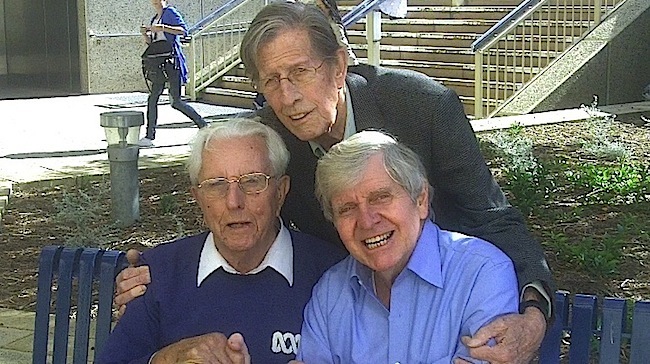
Murray Jennings catered not only for folk and bush bands but also to the Australian psyche. For the musicians servicing this need, were also catering to the basic Aussie mind, soul and spirit. The many talented locals who pursued this form of home grown entertainment.
Murray not only enabled the Western Australian public a chance to witness this alternative culture by offering opportunities for the music to be heard, but enthusiastically promoted the bands and venues where live performances could be experienced in the flesh.
The Sunday Times reported on this phenomenon in November 1985, after Murray had been servicing this area for the previous decade. Oddly enough, the article mentioned the ‘tiny’ studio from which this was being broadcast, whereas in fact, the studio was rather large by normal broadcast standards. Not only did it accommodate Murray and all the broadcasting paraphernalia down one end, with space also to interview a number of guests, but there was sufficient space down the other end to accommodate a band, or as in one case a band and a group of clodhopping dancers, in appropriate colourful attire.
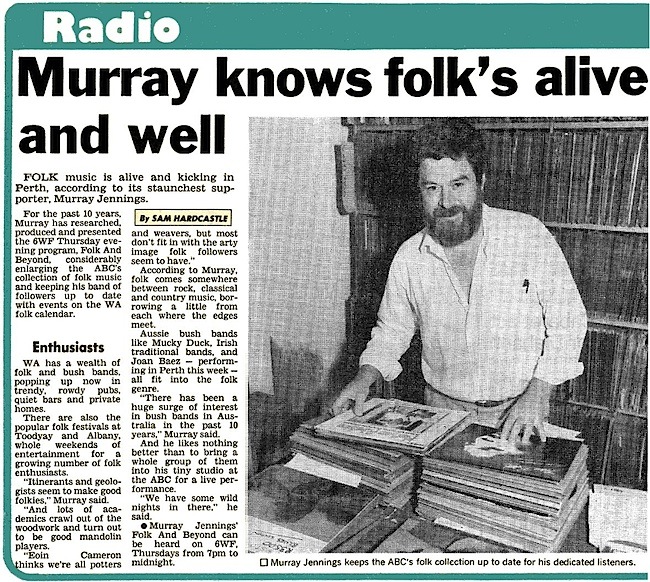
This proved most entertaining to the studio crew, as not only were they witness to the quirky performance, but also the visuals that the radio listeners were missing out on.
Murray Jennings picks up the story:
“Yes, that was one of my proudest moments, broadcasting live on radio, the Perth Morris Men, in their full dress gear, with their sticks and bells. The audience could ‘see’ the action as clearly as if they were in the studio with us. When I was at 6IX in 1967-69, a Macquarie Network slogan was ‘Radio is TV for people with imagination’.
We got great phone calls and letters after the Morris Men’s performance.
Not as easy to convey to a listening audience were Kel Watkins’s ‘String Stories’, told with commentary while he did amazing things with string figures. We enjoyed a few contemplative silences during that one. But it did inspire a lot of people to turn up at his Folk club gig the following weekend.
At that point, for the record, strong mention should be made of the Tech Ops who helped me set up the live broadcasts. I say ‘helped’, meaning that I couldn’t have operated without them. Especially as 95% of them obviously enjoyed getting really involved. This willing co-operation carried on into those last years in the late 1980s when I fronted ‘Country Calling’ for Producer, Jon Farkas.
As with such events as the W.A. Folk Festivals and some Folk concerts attended by ABC recording crews, these blokes (most listed below) went all out to help with live Country music events, such as the Langley Park set-up for the 1988 Bi-Centenary celebrations, the Corrigin Tractor Pull weekend, the Northam Country Music weekend, and our crazy spectacular in the ABC’s upper carpark, with the audience hanging out of the apartment windows next door, or on plastic chairs, displacing the cars, while the late Kevin Daly (comedy writer and performer) did his comedy routine and he and I tried to do a two-hander until the wind blew some pages of his script from his clipboard and when someone handed them back to him in the wrong order, I said it didn’t matter, nobody will notice (they were very Spike Milliganesque) and I was right.
Some Tech Op names (in no order of priority): Peter Burnett, Bruce Jones, the late Bob Weggelaar and John Hewitt, Edo Brands, Graham Boyd, Dave Carlisle, Craig Balmer, James O’Shea, Ken Brand, etc etc…
Regarding jazz, Harro and Ron Morey, etc… I’m happy to say that I was able to fill in for Harro when Ron was taken off air. Jazz has always been as big as ‘Folk’ related music to me, so I had a couple of very enjoyable stints, especially in the late 80s, not long before the Sydney Broadcasting Corporation shut us down.
Also, in the interests of accuracy, other announcers were skilled and interested enough to step into the shoes of specialist presenters when the latter went on annual leave, or were sick.
Tony Clough, Doug Foley, Robyn Johnston… all three of them filled in magnificently on Folk & Beyond, not just as a ‘holding operation’…they did their research and enjoyed it.
The multifaceted George Manning broadcast in many roles from newsreading, breakfast, stints on 6WN, occasion television appearances and many years as a regional program manager. George also energetically presented the golden oldies before the themed evenings came to an end.
Sadly these unique Western Australian shows were dropped by dictate of the ABC’s head office bosses, to be substituted by a less popular format that Sydney insisted upon, in the lead up to centralised program distribution, as happened with television.
The Aussat satellite was enabling the inexpensive distribution of programs across the continent, and new technology was enabling time zone delaying that was no longer labour intensive. This turned 6WN into Radio National, with the content being presented on the east coast. This also impacted on 6WF, now called 720, but not to the same extent as this network was wisely deemed ‘local radio’.
One of the casualties on 6WN was the bright and breezy breakfast session presented by Charles Southwood with producer Tony Howes. Prior to this show, 6WN listeners were subjected to a long session of depressing music more suited to increasing suicide statistics than waking people up in a happy and joyous frame of mind, for the entire session was devoted to funeral music and dirges of the most morbid nature. This was in stark contrast to the effervescent personality of Charles, who had to suppress his charm and wit, as anything approaching happiness was out of character with the archaic programming philosophy of that day.
At this time, Eoin Cameron was providing his own form of breakfast anarchy on 6WF, in the studio next door.
There were times when both 6WN and 6WF crews would enjoy a communal cuppa during a shared news bulletin in the Duty Supervisor’s office, where Eoin would share his latest politically incorrect humour with the teams to much mirth and merriment. The intellectually amusing Charles was a wonderful foil for Cameron during these off air moments, which invariably were more entertaining than anything being broadcast. It would brighten the whole day up for the lucky staff who got to enjoy these extraordinary happenings.
Unfortunately management was not amused when this frivolity extended on-air one morning when Eoin, who would occasionally monitor the solemn and depressing musical proceeding on 6WN, launched a mischievous attack on his friend and colleague in the neighbouring serious music studio. He caught Charles mid sentence, as he was pulled from his chair whilst Eoin commandeered the microphone, to subject his unique form of anarchy upon an audience not accustomed to such indiscretions and wanton informality.
Eoin was no doubt suitably chastised for this rebellion, which management really couldn’t do too much about as his refreshing style has taken 6WF to the top of the ratings. A role Eoin has continued to do for many decades, with a few breaks, much like the former vaudevillian John Juan had in an earlier era.
Eventually the 6WN breakfast was revamped with Charles at the helm, as a much more entertaining affair of bright music and happenings, until Radio National was launched on that frequency and Charles was seconded to the ABCFM network, which was based in Adelaide.
The popular 6WF evening themes, which were unique to WA, were to be lost over the course of many management changes and the eventual displacement of all the presenters who made that possible, during the halcyon days of ABC local radio broadcasting. For there was a movement away from entertainment as people with journalistic skills were preferred to those with trained voices. Talkback and chat programs took their place.
The solution is to grasp new technologies and opportunities that can provide a local voice
Much has changed over the decades as more listening choices become available. There was the movement away from the AM band to FM, the introduction of a myriad of narrowcast and community stations and the many new digital stations, not to mention the thousands of Internet based radio outlets. In addition there are the podcasts which have become increasing popular among the younger generations.
Video podcasts and internet only IPTV shows are also appearing, so once the new high speed National Broadband Network becomes established, even more opportunities will become available to broadcast content without need for a licence or the heavy handed approach of old media management. All manner of innovation will be possible and hopefully popular concepts which we experienced on ABC local radio in the 1970s and 1980s can once again flourish and provide an impetus to local talent and local interests, which were denied in the name of centralisation.
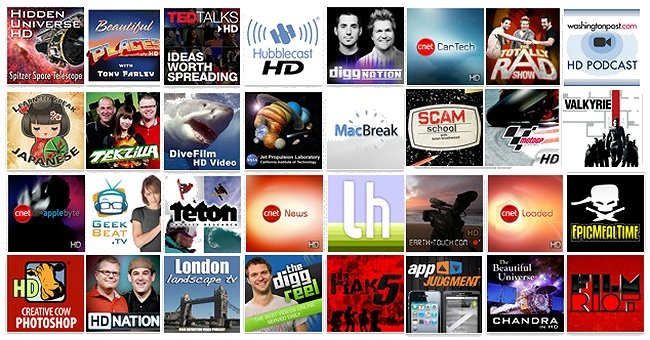
Not only home users seeking entertainment, but schools, colleges and universities have taken to podcasts as an easy means of distributing education worthy content aimed at children, young people, teachers and parents.

There are literally thousands of podcasts available from a variety of sources. Some are audio podcasts in MP3 format, others are standard and high definition video podcasts of broadcast quality.
It is possible for the bastions of old media to consider podcast technology as being disruptive, as they do not adhere to the usual radio and television business model regarding established practices and preconceptions about audiences, consumption, production and distribution.
This is because no one person owns the technology; it is free to listen and create content, which departs from the traditional model, where instead producers are consumers and consumers become producers and can engage in conversations with each other via the Internet.
The iTunes Store puts thousands of free podcasts at your fingertips, using a simple to use interface. There are charts to indicate new releases and list them by popularity. A selected podcast can either be streamed or downloaded. It is also possible to subscribe so that no episodes are missed. iTunes also enables you to manage your podcasts so that items played can be identified compared to those yet unheard or viewed. You too can be a producer and participate.

This concept gives the user full control over their content, so that it is available on demand, rather than the user be subject to the program choice of another.
iTunes then extends this concept to include television shows and movies, so that a similar degree of control is available. Though in this case the content is for hire or sale.
Another aspect of Podcasts and on-demand TV shows is that most free-to-air live programs go out at a specific time, and unless one is continuously recording them, the content will be missed. Whereas the downloads can be viewed whenever convenient and kept if there is something important on the show.
These concepts may be alien to the older generations, but are common knowledge and use by the younger generation.
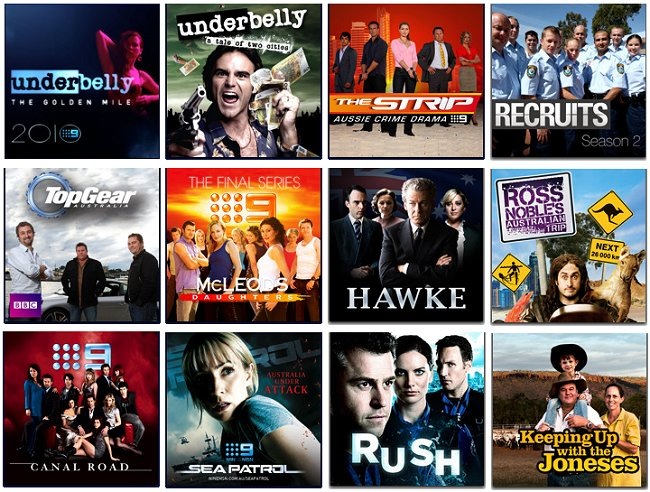
This is why old media broadcasting is at risk in the long term unless it can reinvent itself. Content production and sales is another matter, as the public have an insatiable appetite for content in one form of the other. This also included the ever increasing sophistication of computer games which are appearing more as interactive movies where the player is one of the characters and the story has a large variety of outcomes. This means that the player does not tire after one session, as they can play endlessly until attracted by the next high technology game incarnation.

Using the internet, we’re not forced to take content other than what we desire. Because the United States has pioneered much of this, they then were the first wave. Western Australians can also be part of this revolution, as we don’t have to wait for government approval, as the government is still scratching its head on how to control it. It just needs locals to take the reins in their hands to blaze a new trail, as our radio and television pioneers were doing decades ago.
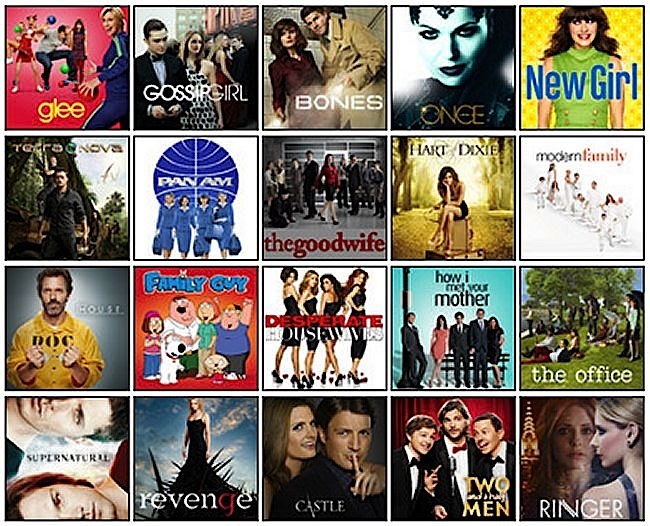
A very wide range of US TV shows are on iTunes for rent or buy
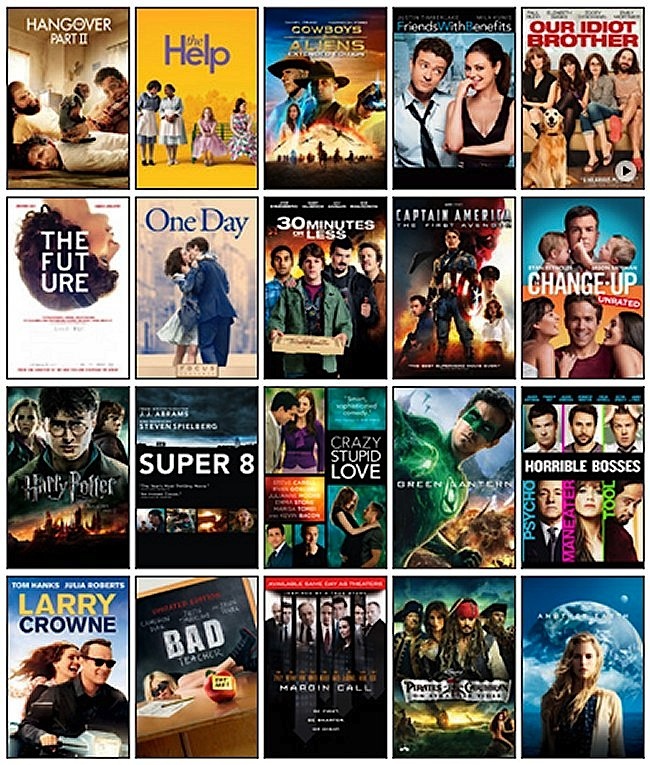
Recent Movie Releases on iTunes for rent or buy
Learning techniques and the available multimedia rich tools make the old classroom blackboard obsolete, and with it the painstaking copying of mind numbing notes into an exercise book as archaic as the dead sea scrolls. Technology is changing at such a rapid rate that our future leaders will have to keep up. There’s little point teaching yesterdays techniques to tomorrows teenagers.
The WA colleges, academies and universities are training new batches of youngsters each year, though often they learn faster than the education system can cope. Particularly when it comes to computer skills. Some children are proficient navigating an iPad before they can even speak. Its an exciting new world, we just need to make sure that we give our youth all the opportunities they can get, to not only learn but also to put these newly acquired skills to good use… without being forced to go over east or over seas to achieve it.
The WA based people who are acquiring these skills need an outlet here to express them… otherwise the siphoning off to Sydney and Melbourne will be ongoing.
We often hear people complain how dull Perth is. Its possibly because of the endless brain and talent drain, as demonstrated by the many Western Australians who have excelled on leaving our State.
Hopefully resources can be directed at making this possible, otherwise our education services will continue to benefit the eastern states. Meanwhile, we should not forget the broadcasting veterans who can provide a mentoring role. The means of program delivery may change over time but the basic concepts of good program making do not.







